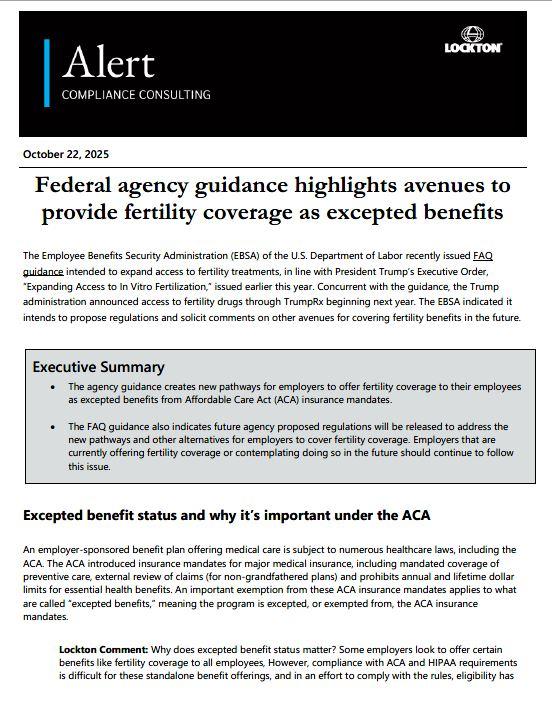Skip to main content

ALERT / OCTOBER 22, 2025
Federal agency guidance highlights avenues to provide fertility coverage as excepted benefits
7 MIN READ
The Employee Benefits Security Administration (EBSA) of the U.S. Department of Labor recently issued FAQ guidance (opens a new window) intended to expand access to fertility treatments, in line with President Trump’s Executive Order, “Expanding Access to In Vitro Fertilization,” issued earlier this year. Concurrent with the guidance, the Trump administration announced access to fertility drugs through TrumpRx beginning next year (opens a new window). The EBSA indicated it intends to propose regulations and solicit comments on other avenues for covering fertility benefits in the future.
Executive Summary
The agency guidance creates new pathways for employers to offer fertility coverage to their employees as excepted benefits from Affordable Care Act (ACA) insurance mandates.
The FAQ guidance also indicates future agency proposed regulations will be released to address the new pathways and other alternatives for employers to cover fertility coverage. Employers that are currently offering fertility coverage or contemplating doing so in the future should continue to follow this issue.
Excepted benefit status and why it’s important under the ACA
An employer-sponsored benefit plan offering medical care is subject to numerous healthcare laws, including the ACA. The ACA introduced insurance mandates for major medical insurance, including mandated coverage of preventive care, external review of claims (for non-grandfathered plans) and prohibits annual and lifetime dollar limits for essential health benefits. An important exemption from these ACA insurance mandates applies to what are called “excepted benefits,” meaning the program is excepted, or exempted from, the ACA insurance mandates.
Lockton Comment: Why does excepted benefit status matter? Some employers look to offer certain benefits like fertility coverage to all employees, However, compliance with ACA and HIPAA requirements is difficult for these standalone benefit offerings, and in an effort to comply with the rules, eligibility has to be limited to only those enrolled in the major medical plan. These pathways could allow for excepted benefit status enabling fertility coverage to be offered to all employees without running afoul of the ACA and HIPAA rules.
Under the current scheme, excepted benefits can include dental and vision coverage, health flexible spending accounts (FSAs), some health reimbursement arrangements (HRAs), employee assistance plans (EAPs) and insured indemnity-type coverages, such as hospital indemnity and dread disease coverage.
Lockton comment: So, what happens if an employer offers coverage that doesn’t qualify as an excepted benefit? The program will be subject to a variety of mandates (such as the ACA mandates described above) which are difficult to satisfy on a stand-alone basis, exposing the plan sponsor to an excise tax of $100 per day under the Tax Code “with respect to each individual to whom such failure relates.” In addition, program participants could also file lawsuits under ERISA to enforce the ACA insurance mandates against the program.
Avenues for stand-alone fertility coverage to qualify as excepted benefits
The new FAQ guidance highlights ways for fertility coverage to be deemed excepted benefits.
Insured fertility coverage (independent, non-coordinated benefits). For fertility benefits to qualify, the coverage must meet the following three requirements: (1) the fertility benefits are provided under a separate policy, certificate, or contract of insurance; (2) there is no coordination between the provision of such benefits and any exclusion of benefits under any group health plan maintained by the same plan sponsor; and (3) the benefits are paid with respect to an event without regard to whether benefits are provided with respect to such event under any group health plan maintained by the same plan sponsor.
Lockton comment: Fully insured, stand-alone fertility coverage options are limited and are currently not available in most state insurance markets. Many employers covering fertility benefits outside the major medical plan utilize self-funded options to fund these benefits.
The guidance indicates that if all of the above requirements are met to be deemed an excepted benefit, stand-alone, fully insured fertility coverage can be offered to all employees, including those who do not enroll in (or qualify for) the employer’s medical plan. Further, the coverage will not interfere with an employee’s eligibility to contribute to a health savings account (HSA) if they are covered under a high-deductible health plan.
Lockton comment: The guidance indicates that self-funded fertility coverage would not qualify as an excepted benefit. We assume regulators do not intend this to mean that a self-funded health plan cannot provide fertility coverage as a benefit under its major medical plan, as many employers currently do. However, employers offering self-funded fertility coverage to employees not also enrolled in the major medical plan, but as a stand-alone benefit offering, would not qualify as an excepted benefit and would run afoul of the current ACA rules for major medical insurance. We expect clarification on these issues when the agency issues proposed regulations on the topic.
Excepted Benefit HRA for fertility benefits. To qualify as an excepted benefit HRA, the HRA must meet the following four requirements: (1) Other group health plan coverage that is not limited to excepted benefits and that is not an HRA or other account-based group health plan is made available by the same employer/plan sponsor for the plan year to the participant; (2) Amounts newly made available for each plan year under the HRA or other account-based group health plan do not exceed $2,200 for 2026; (3) The HRA must not reimburse premiums for individual health insurance coverage or group health plan coverage; (4) The HRA or other account-based group health plan is made available under the same terms to all similarly situated individuals, regardless of any health factor.
Lockton comment: An excepted benefit HRA could be a viable option for employers who want to offer fertility benefits but limit the financial exposure, as the maximum allowable HRA reimbursement is limited under the rules. Employers will want to also consider that the cost of an average round of fertility benefits can range anywhere from $15,000 to $25,000, which far exceeds the $2,200 maximum allowable reimbursement for 2026.
Employee assistance programs. The FAQ guidance also highlights the ability of employer plan sponsors to leverage current guidance surrounding EAPs, allowing an EAP to be viewed as an excepted benefit so long as certain requirements are met, including, but not limited to, that the EAP not be coordinated with benefits under the major medical plan, must not tie eligibility under the EAP to coverage under the major medical plan and the EAP not provide “significant benefits in the nature of medical care.”
Note, regulators have provided limited guidance as to what would be deemed “significant benefits,” but it is likely that coverage of fertility drugs and fertility procedures would be viewed as significant, making this a hard pathway to provide fertility benefits as an excepted benefit unless the employer is merely offering coaching or assistance in finding medical providers who provide such services.
Lockton comment: Practically speaking, most employers offering fertility benefits are looking to provide medical benefits such as access to prescription drugs and coverage of services like in vitro fertilization and intrauterine insemination. Although the EAP is an interesting avenue, most employers are likely gravitating toward the other options described above in order to provide coverage for more robust fertility benefits.
What does all of this mean?
Employers should continue to prioritize clinical guidance to ensure fertility care is safe, effective and personalized. Expert oversight streamlines treatment, reduces unnecessary steps, improves success rates and minimizes risks. This approach drives better outcomes, controls costs and gives employees confidence throughout a complex process.
The FAQ guidance is informal, and doesn’t necessarily create new avenues for fertility coverage, but rather expands on existing rules to provide fertility coverage. Note though, the agency intends to issue proposed regulations in the future. Employers who currently offer fertility coverage or are contemplating doing so in the future will need to stay informed on this issue.
Not legal advice: Nothing in this alert should be construed as legal advice. Lockton may not be considered your legal counsel, and communications with Lockton's Compliance Consulting group are not privileged under the attorney-client privilege.
For more alerts, insights and additional information, click here (opens a new window) to visit Lockton's ERISA Compliance Consulting page.
 Download alert (opens a new window)
Download alert (opens a new window)

by Mark Holloway
Senior Vice President, Director, Compliance Consulting

